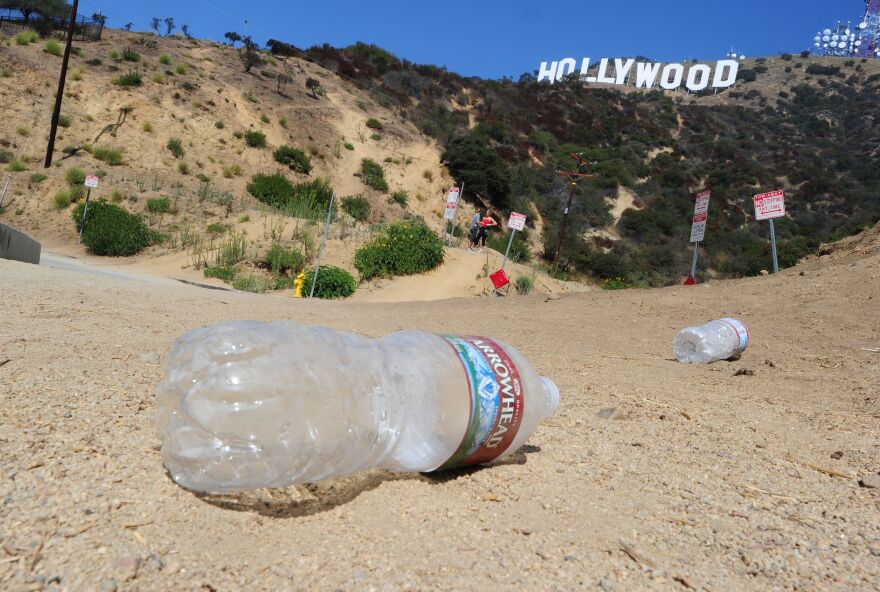California's Landmark Plastics Law Affects Just About Every Kind Of Plastic Packaging You See

You’ve seen the heart-wrenching photos of marine life trapped and choked by plastic. There’s a laundry list of problems caused by the stuff: it’s filling up landfills, polluting the environment, harming public health, and, yup, the industry is also fueling the climate crisis. Now California has passed a landmark law to help turn the tide.
SB 54 will affect just about every type of plastic packaging you see at stores throughout the state. Here are the major requirements:
- All single-use packaging and food service ware must be recyclable or compostable by 2032.
- The industry will need to cut single-use plastic waste by 25% and grow plastics recycling 65% by 2032.
- CalRecycle, the state agency that regulates waste management, will be tasked with making sure plastic producers comply with the law. Plastic manufacturers will need to submit a plan to the agency on how they’ll achieve the requirements, as well as report yearly progress.
- If a plastic manufacturer isn’t abiding by the rules, they’ll face penalties of $50,000 per violation per day.
- The law requires plastic producers to pay $500 million a year over 10 years ($5 billion by 2032) to a fund to address the impacts of plastics on the communities most harmed by the industry.
Why It's Being Lauded By Advocates
The bill is being lauded by many as the nation’s most comprehensive law to phase out single-use plastics and packaging. The Ocean Conservancy, one of the nonprofits that helped craft the law, estimated it could eliminate nearly 23 million tons of single-use plastic packaging and foodware by 2032 — that’s nearly 26 times the weight of the Golden Gate Bridge, according to the group.
That matters, because most plastic doesn’t even get recycled. A 2018 global study found that only 9% of plastics get recycled, while the rest ends up in landfills, as litter, or in the ocean. The COVID-19 pandemic only made the situation worse.
Assemblymember Luz Rivas chairs the Natural Resources Committee and pushed for stricter environmental requirements that ended up in the final legislation.
-
At magnitude 7.2, buildings collapsed
-
Now spinning in front of Santa Monica apartments
-
Advocates seek end to new LAUSD location policy
“As someone who grew up and represents the East San Fernando Valley, I've seen firsthand how disadvantaged and low-income communities bear the brunt of pollution, including plastic pollution,” she said in a phone interview.
The fossil fuel, petrochemical and plastic industries are cozy bedfellows, and are most often located in low-income communities of color, which disproportionately suffer the health effects of being near such facilities. For decades, the fossil fuel and petrochemical industries have promoted the development of oil-based plastic products while hiding the health and environmental harms, according to California Attorney General Rob Bonta, who launched an investigation into the industries in April.
Plastics don’t only litter communities and the environment — the U.S. plastics industry alone is responsible for at least 232 million tons of carbon emissions per year, an amount equivalent to the average emissions from 116 average-sized coal-fired power plants, according to a 2021 study.
Not everyone’s so excited, though. In a statement, the American Chemistry Council, which participated in the negotiations around SB 54, wrote, “the definition of recycling needs to be improved and made clearer so new, innovative technologies that keep hard-to-recycle plastic out of the environment and landfills count in achieving the circularity goals in the legislation.”
But Marce Gutiérrez-Graudinš, founder of grassroots group Azul, said California’s law addresses the issue more holistically than has been done before.
“We need to think about abating plastic pollution, not just because of ocean pollution, but because of the impact that it has on all of our habitat, especially on people,” she said.
She spoke to us from the United Nations Oceans Conference in Lisbon, Portugal, where a major topic of discussion is the development of a global treaty to address plastic pollution. She said California’s law provides a model.
“The eyes of the world are on us, and so it’s exciting to see California set forth such a good example,” she said.
Gutiérrez-Graudinš said there’s still far more to be done, but California’s new law is a step in the right direction.
-
The state's parks department is working with stakeholders, including the military, to rebuild the San Onofre road, but no timeline has been given.
-
Built in 1951, the glass-walled chapel is one of L.A.’s few national historic landmarks. This isn’t the first time it has been damaged by landslides.
-
The climate crisis is destabilizing cliffs and making landslides more likely, an expert says.
-
Lifei Huang, 22, went missing near Mt. Baldy on Feb. 4 as the first of two atmospheric rivers was bearing down on the region.
-
Since 2021, volunteers have been planting Joshua tree seedlings in the Mojave Desert burn scar. The next session is slated for later this Spring, according to the National Park Service. Just like previous times, a few camels will be tagging along.
-
There are three main meteorological reasons why L.A. is so smoggy — all of which are affected when a rainstorm passes through and brings clearer skies.









